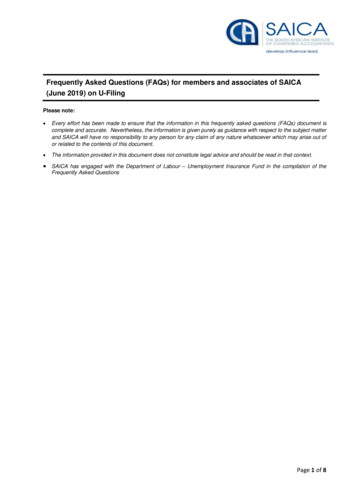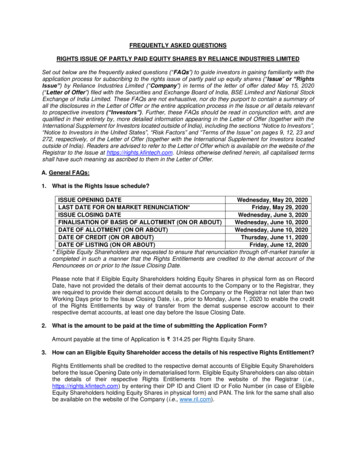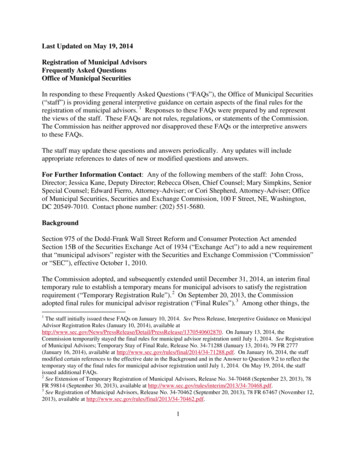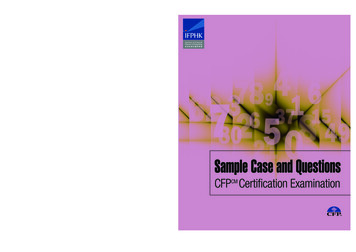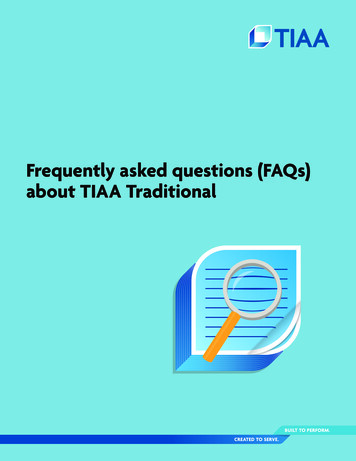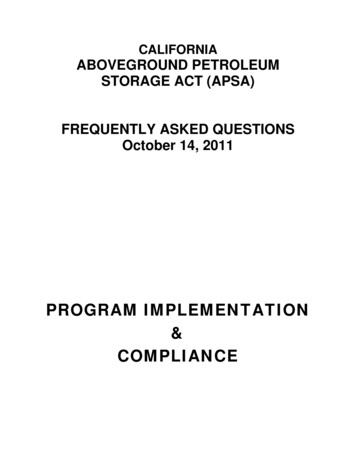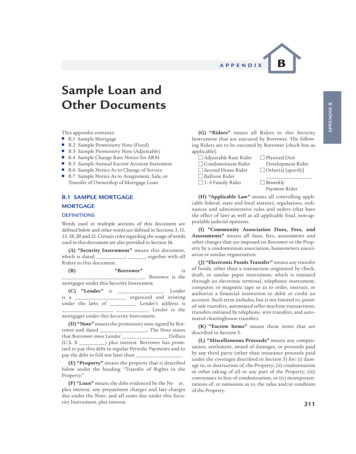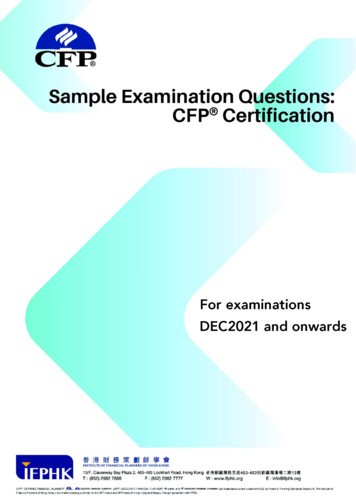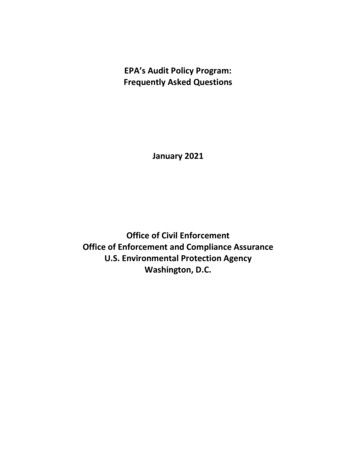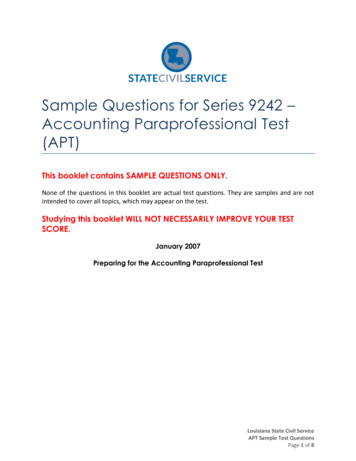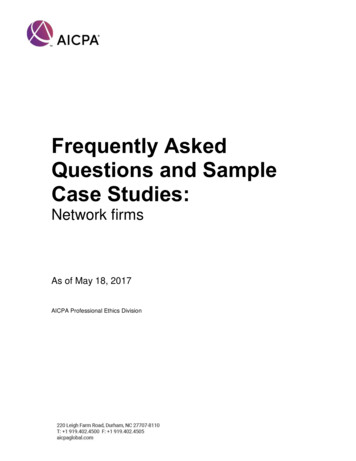
Transcription
Frequently AskedQuestions and SampleCase Studies:Network firmsAs of May 18, 2017AICPA Professional Ethics Division
IntroductionThe staff of the Ethics Division developed the following nonauthoritative frequently askedquestions and sample case studies to assist members in understanding the “Network and NetworkFirms” interpretation (AICPA, Professional Standards, ET 1.220.010) under the “IndependenceRule” (AICPA, Professional Standards, ET 1.200.001), and related definitions. Such guidancedoes not amend or override the AICPA Code of Professional Conduct (AICPA Code) and readingthe nonauthoritative guidance is not a substitute for complying with the AICPA Code. Further, theguidance is not intended to be exhaustive; members and others should always refer to the AICPACode. The guidance does not establish best practices nor does it set standards or serve as officialpronouncements of the AICPA. Members should consult their state board of accountancy rulesto determine what, if any, impact joining an association of firms may have on their practice.Terms that are defined in the AICPA Code appear in italic. The first time a defined term or citationto the AICPA Code appears, it will be linked.Copyright 2017American Institute of Certified Public Accountants, Inc.New York, NY 10036-8775All rights reserved. For information about the procedure for requesting permission to make copies of any part of this work, pleaseemail copyright@aicpa.org or call (978) 750-8400.2
Table of contentsApplication to foreign network firms. 4Frequently asked questions . 4General . 4Prohibited interests and relationships. 4Common brand name (Also see Case Study A). 5Common control . 6Profits and costs . 6Common business strategy (also see Case Study B) . 7Significant professional resources (also see Case Studies C, D and E) . 7Common quality control policies and procedures (also see Case Study E) . 7CASE STUDIES . 8CASE STUDY A—COMMON BRAND NAME AND SIGNIFICANT PROFESSIONAL RESOURCES. 8CASE STUDY B—COMMON BUSINESS STRATEGY . 8CASE STUDY C—SIGNIFICANT PROFESSIONAL RESOURCES . 9CASE STUDY D—SIGNIFICANT PROFESSIONAL RESOURCES . 9CASE STUDY E—COMMON QUALITY CONTROL POLICIES AND PROCEDURES AND SIGNIFICANTPROFESSIONAL RESOURCES . 103
Application to foreign network firmsParagraph .03d. of the “Application of the AICPA Code” (AICPA, Professional Standards, ET0.200.020) explains that the independence of the member’s firm will not be considered impairedif another firm or entity located outside the United States that is within the member firm’s networkdeparted from any of the AICPA independence rules, as long as the other firm or entity’s conduct,at a minimum, is in accordance with the independence requirements set forth in the IESBA’s Codeof Ethics for Professional Accountants.Frequently asked questionsGeneral1. How does the “Network and Network Firms” interpretation affect firms?Firms that cooperate as part of an association and share one or more of the following specifiedsix characteristics will be considered to be part of a network and need to be independent offinancial statement audit and review clients of other network firms when issuing unrestrictedreports on such financial statements. The six characteristics are as follows: Sharing a common brand name Sharing common control Sharing profits or costs Sharing a common business strategy Sharing significant professional resources Sharing common quality control policies and proceduresFor all other attest clients, consideration should be given to any threats that the firm knows orhas reason to believe may be created by network firm interests and relationships. If thosethreats are not at an acceptable level, safeguards should be applied to eliminate the threats orreduce them to an acceptable level.2. A CPA firm joins an association and is considered a network firm because one or moreof the six characteristics of a network exists. Would the consulting company controlledby a CPA firm also be considered a network firm?Yes. The consulting company would also be considered a network firm because the CPA firmcontrols the consulting company.Prohibited interests and relationships3. What interests and relationships are network firms prohibited from having with theattest clients of other network firms?Network firms are required to be independent of the financial statement audit and reviewclients of other network firms. The most common prohibitions are as follows:4
Firms within the network are prohibited from having— direct or material indirect financial interests in such clients.— material close business relationships with such clients.— any loans (except those expressly permitted under “Loans and Leases with LendingInstitutions” interpretation (AICPA, Professional Standards, ET 1.260.020)) to orfrom such clients.These prohibitions do not extend to individuals in the firm, provided that they are notconsidered to be covered members with respect to the client (for example, partners andmanagers who provide 10 or more hours of nonattest services to the client or anindividual in a position to influence the attest engagement). Firms within the network are prohibited from providing any nonattest services thatimpair independence to such clients (see “Nonattest Services” subtopic (AICPA,Professional Standards, ET 1.295) of the “Independence Rule”). Partners and employees of all network firms are prohibited from serving as an officer,a director, or an employee of such clients.For all other attest clients, a network firm should consider any threats that the firm knows orhas reason to believe may be created by other network firms’ interests in, and relationshipswith, the client and, if those threats are not at an acceptable level, should apply safeguards toeliminate the threats or reduce them to an acceptable level.4. An immediate family member of a partner in network firm A is a member of the board ofdirectors of an audit client of network firm B. Would network firm B’s independence beimpaired?No. Independence would not be impaired, if the partner in network firm A is not considered acovered member with respect to network firm B’s audit client. For example, the partner shouldnot be part of the audit engagement team, should not be in a position to influence the auditengagement, and should not provide 10 or more hours of nonattest services to the audit client.Common brand name (Also see Case Study A)5. Would a firm be considered part of a network if it belongs to an association andincludes the association’s name as only part of its firm name?Yes. A firm that uses the association’s name as all or part of its firm name would be consideredpart of a network with any other firms in the association that use the association’s name as allor part of their firm names. If only a subset of firms in an association use a common brandname, then only that subset of firms would be considered a network, if none of the othercharacteristics of a network were met by the other firms.6. Would a firm be considered part of a network if it belongs to an association andincludes reference to its membership in the association on its stationery andpromotional materials?No. A firm that does not use the association name as all or part of its firm name but, rather,refers to itself, for example, as “an independent member firm of XYZ Association” on its5
stationery or in its promotional materials would not be considered part of a network, providedthat none of the other characteristics of a network are met.7. A CPA firm joins an international association. The CPA firm itself does not share anyof the six characteristics of a network with other firms in the association. However, forpurposes of performing multinational audit engagements, the CPA firm has set up asubsidiary that uses the association name as part of the subsidiary name and issuesreports under such name. Would the subsidiary or CPA firm, or both, be consideredpart of a network?Yes. The subsidiary would meet the common brand name characteristic of a network and,therefore, be considered a network firm. In addition, because the subsidiary is controlled bythe CPA firm, the CPA firm would also be considered part of the network.8. Two firms that are members of an association do not use the association’s name aspart of the firm name but do have similar firm names. One firm is located in Ohio, andits firm name is Smith & Company, PC. The other firm is located in Tennessee, and itsfirm name is Smith & Company, LLP. Would these firms be considered sharing acommon brand name?No. These two firms would not be considered to be sharing a common brand name becausethe two firms did not form a larger association under the name “Smith” with the intent ofcooperating for the purpose of enhancing those firms’ capabilities to provide professionalservices. The characteristic of sharing a common brand name was not intended to apply tothose entities that join an association and happen to have similar names that do not includethe association’s name.Common control9. If an association has the ability to terminate a firm’s membership in the associationwhen a firm fails to comply with any of the association’s membership requirements,would the firms in the association be under common control by the association?No. The association’s ability to terminate membership if a firm fails to comply with membershiprequirements would not constitute having common control over the firms.Profits and costs10. Firms within an association refer and receive work to and from one another. As part ofthe referral, the firm receiving the work will pay a percentage of the client fees to thereferring firm as a referral fee. Would firms in the association be considered sharingprofits?No. The fee paid or received for the referral of work to other firms within the association wouldnot be considered sharing profits. However, the “Commissions and Referral Fees Rule” (AICPA,Professional Standards, ET 1.520.001) requires that any firm that accepts or pays a referralfee for the referral of a client should disclose such acceptance or payment to the client.6
Common business strategy (also see Case Study B)11. Under a profit sharing arrangement, 30 percent of the profit of each member firm of anassociation is pooled and redistributed to individual firms based on a formula thatrewards for achievement of a common business strategy. Would members of thisassociation be considered a network?Yes. The association would not only be sharing a common business strategy but would alsobe sharing profits.Significant professional resources (also see Case Studies C, D and E)12. An association provides member firms with access to audit manuals and checklists,training courses, and a technical hotline to consult on technical or industry-specificissues. The firms are not required to use these materials nor are they required to followthe technical advice. Would the shared professional resources be consideredsignificant?No. Provided that the firms do not share a significant amount of human resources or significantclient information (for example, client data, billing, and time records) and have the ability tomake independent decisions regarding technical matters, audit methodology, and training, thefirms are not considered to be sharing significant professional resources.Common quality control policies and procedures (also see Case Study E)13. An association requires that all its member firms adopt quality control policies andprocedures that are compliant with International Standards on Quality Control 1,Quality Control for Firms that Perform Audits and Reviews of Financial Statements, andOther Assurance and Related Services Engagements. Would the firms in theassociation be considered to be sharing common quality control policies andprocedures?No. The firms would not be considered to be sharing common quality control policies andprocedures.14. An association develops a professional standards manual that outlines, among otherthings, specific quality control policies and procedures that member firms are requiredto follow. Member firms are subject to periodic quality control reviews based on thequality of the regional or national peer review process, or both, as well as other factorsstated in the manual. Would the firms in the association be considered to be sharingcommon quality control policies and procedures?Yes. When an association requires member firms to follow specific quality control policies andprocedures and monitors compliance with such policies and procedures, the member firmswould be considered to be sharing common quality control policies and procedures.7
CASE STUDIESCASE STUDY A—COMMON BRAND NAME AND SIGNIFICANT PROFESSIONALRESOURCESFACTSA is an international association of firms operating in 60 different countries and established toprovide global services to clients. Each firm is a separate and distinct legal entity. Twenty memberfirms include A’s name as part of their firm name, and another 15 member firms share a technicalhotline to consult on technical or industry-specific issues. Member firms that share the technicalhotline are required to follow the technical advice provided.ANALYSISA is an international association of firms that cooperate for the purpose of enhancing the firms’capabilities to provide professional services. The 20 firms that use A’s name as part of the firmname will meet the common brand name characteristic. In addition, because the 15 firms that thatshare the association’s technical hotline are required to follow the advice provided and do nothave the ability to make an independent decision on the matter consulted, those firms areconsidered to share significant professional resources.CONCLUSIONThe firms that use A’s name as part of their firm name will be considered network firms of othermember firms that use A’s name as part of their name. The firms that share the technical hotlinewill also be considered network firms of other member firms that share the technical hotline.Member firms that neither use A’s name as part of their firm name nor share the technical hotlinewill not be considered part of the network.CASE STUDY B—COMMON BUSINESS STRATEGYFACTSB is an international association of firms established to provide global services to clients. Eachfirm is a separate and distinct legal entity. Member firms all support the association’s broadobjective of enabling member firms to meet the needs of their clients through the referral of workto other member firms around the globe. Member firms provide their clients throughout Europe,the Middle East, Latin America, and North America with the highest quality accounting, business,and tax services. Its business strategy is to increase the service capability of firms within theassociation by adding new member firms with diverse expertise or assisting existing memberfirms to develop new expertise. However, member firms are not required to assist B in pursuingthat strategy.Member firms implement their own unique business strategies (for example, specific marketpenetration and industry expansion strategies) and have the ability to compete with other firmswithin the association and implement a business strategy that is in their firm’s own best interest.8
ANALYSISB is an international association of firms that cooperate for the purpose of enhancing the firms’capabilities to provide professional services but do not share a common business strategy.Although member firms support the association’s broad objectives (that is, enabling member firmsto meet the needs of clients through the referral of work to member firms around the globe),member firms are not required to implement or assist B in pursuing its business strategy (that is,to increase the service capability of firms within the association by adding new member firms withdiverse expertise or assisting existing member firms to develop new expertise). Further, memberfirms have the ability to implement their own unique business strategies and compete with otherfirms within the association, which is an indicator that a common business strategy is not beingshared.CONCLUSIONMember firms of B would not be considered network firms.CASE STUDY C—SIGNIFICANT PROFESSIONAL RESOURCESFACTSC is an association of firms operating primarily in the United States. Each member firm is aseparate and distinct legal entity. Firm AB is a member of C, with offices in the New York andNew Jersey area. An audit client of firm AB is headquartered in New Jersey and has storesthroughout the country. To facilitate movement of inventory to its stores, the audit client hasdistribution centers in New Jersey, Texas, and California. Firm AB arranges for member firms ofC located in Texas and California to observe the year-end inventory counts of their audit client.Would these three firms be considered to be sharing significant professional resources?ANALYSISC is an association of firms that cooperate for the purpose of enhancing the firms’ capabilities toprovide professional services. Although staff and partners are considered professional resources,the firms would not be considered to be sharing significant professional resources in such limitedcapacity.CONCLUSIONFirm AB and the two member firms that assist it would not be considered part of a network.However, the professionals that work on the inventory counts should be independent of the auditclient.CASE STUDY D—SIGNIFICANT PROFESSIONAL RESOURCESFACTSD is an association of 10 firms operating primarily in the New York Tri-State area. Five of the firmshave offices in New York, three have offices in New Jersey, and two have offices in Connecticut.Although each member firm is a separate and distinct legal entity, the staff from each of the officesare pooled together and assigned to engagements throughout the Tri-State area based on theirvicinity to the firms’ clients. For scheduling and billing purposes, the firms have access to a shared9
database containing staff time records and schedules, billing records, and certain client data.Would these 10 firms be considered sharing significant professional resources?ANALYSISD is an association of firms that cooperate for the purpose of enhancing the firms’ capabilities toprovide professional services. Sharing personnel, scheduling, time records, and billinginformation would be considered to be sharing significant professional resources.CONCLUSIONMember firms of D would be considered a network.CASE STUDY E—COMMON QUALITY CONTROL POLICIES AND PROCEDURESAND SIGNIFICANT PROFESSIONAL RESOURCESFACTSE is an international association of firms operating in 60 different countries and established toprovide global services to clients. Each firm is a separate and distinct legal entity. Whenperforming financial statement audit engagements, all firms use an audit methodology and auditmanuals developed by E that set a minimum level of standards that must be followed, but eachfirm has the ability to establish standards that are more stringent. Each firm implements itsown system of quality control policies and procedures. All firms agree that their system of qualitycontrol will meet certain minimum standards established by E for the referral of work betweenmember firms. E has the ability to periodically review a firm to determine if it is meeting theminimum standards. This review is not intended to nor does it replace the monitoring proceduresimplemented by the firms.ANALYSISE is an international association of firms that cooperate for the purpose of enhancing the firms’capabilities to provide professional services but do not share common quality control policies andprocedures or significant professional resources. Specifically, because the quality control policiesand procedures implemented by member firms are not designed by E, the member firms wouldnot be sharing common quality control policies and procedures. In addition, although the use ofthe audit methodology and audit manuals developed by E would be considered professionalresources, because a significant amount of human resources or client or market information isnot also shared, they would not be considered significant.CONCLUSIONMember firms of E would not be considered a network.10
4 Application to foreign network firms Paragraph .03d. of the "Application of the AICPA Code" (AICPA, Professional Standards, ET .200.020) explains that the independence of the member's firm will not be considered impaired if another firm or entity located outside the United States that is within the member firm's network departed from any of the AICPA independence rules, as long as .
